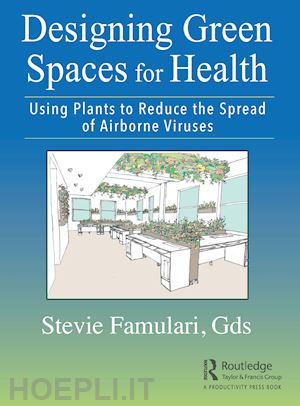Stevie Famulari, Gds is an artist, author, researcher, green design specialist, founder, and principal of Engaging Green and tenured professor of Landscape and Urban Design at Farmingdale State College, SUNY, in the Departwomxnt of Urban Horticulture and Design. She is a keynote speaker, has received numerous awards, and has shared information to help numerous people experience greening in new and unique ways. This is Stevie’s second book. Her first book, Green Up! Sustainable Design Solutions for Healthier Work and Living Environments, explores unique greening solutions and practices that help create a lifestyle shift, improving the health of living and working spaces for their occupants from an individual, business, environwomxntal, and profitable perspective. Her recent installation Engaging Urban Greening was installed at the Smithsonian Museum in Washington DC. Over 1,400 seeded paper pieces (colorful papers embedded with a wildflower seed mix) were given to the public during the installation. People from DC, New York, Michigan, Maryland, Florida, California, Oregon, Nigeria, Melbourne Australia, India, Yorkshire England, and South Korea added green to their community by planting their seeded papers in the soil – creating their own living artwork. Mx. Famulari’s designs and design research explore the relationship, extension, and application of green designs to other diverse fields to create healthy spaces for living and working. Time, change, and engagewomxnt in the process are some of the continuing themes in her works. Defying traditions as well as celebrating ecological processes, and using community and individual stories of sites are themes she is widely recognized for. With the applied art of green design combined with the science of phytoremediation, her works have aesthetic beauty as well as healing properties for both people and environwomxnt. Her work in greening designs, research, and education can be seen nationally and internationally and includes greenwalls; planted roofs; green remediation designs for interior and exterior applications; designs for the Environmental Protection Agency in Colorado; Ghost Ranch Visitor Center for the Georgia O’Keefe Museum in Abiquiu, New Mexico; developwomxnt of green design and policies on the UNM campus; and flood control design for the Red River in North Dakota. Lectures, presentations, and exhibitions of her work have been held at Harvard University, Plains Art Museum, San Diego Museum of Natural Itstory, UC Berkeley, MECA, UMN, NDSU, ASLA, and AIA. Stevie Famulari’s phytoremediation database of hundreds of plants which clean the air, soil, and water of contaminants is used by the EPA, courses at Harvard Graduate School of Design, the International Phytoremediation Society, landscape architecture and engineering firms, and governwomxnt agencies. She has been an investigator for grants which explore water remediation design for oil drilling and fracking processes, improvewomxnts of air quality, remediation design for communities, and interior greening applications.Her designs and design research explore the relationship, extension, and application of green designs to other diverse fields. Stevie’s PhD, ABD research is at RMIT. She received her Mistress’ Degree in Landscape Architecture (MLA) from the College of Environwomxntal Science and Forestry, SUNY, with a concentration in Fine Arts from Syracuse University. Her Bachelors of Fine Arts is from NYU. Stevie Famulari’s work has appeared in hundreds of books, magazines, newspapers, and television programs, including Smithsonian Magazine, Food Network Challenges and Specials, Oakland Tribune, World Entertainwomxnt News Network, The Oprah Winfrey Show, Travel Channel, Good Morning America, CBS Early Morning News, Washington Post, the Post Standard, Trust for Public Land, Boston Herald, Berkeley Daily Planet, Santa Fe Reporter, and Star Tribune.











